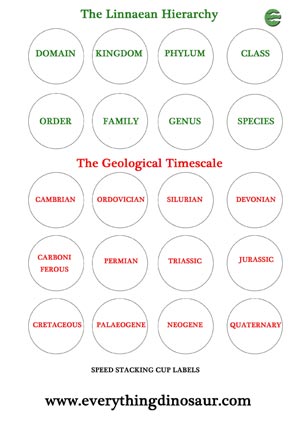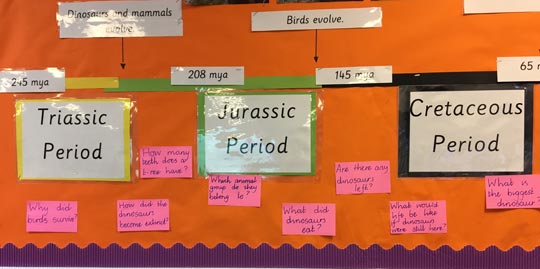Year 5 Getting to Grips with Deep Time
Children in Year 5 at Oasis Academy Short Heath (Birmingham), got to grips with geological timelines as they commenced the term topic entitled “Jurassic World”. The emphasis might be on developing vocabulary and improving writing but there was plenty of evidence of cross-curricular activities on display in the two well-appointed classrooms.
Geological Timelines
Learning About Classification and Geological Timelines

Learn how animals are classified, learn the geological timescale with this speed stacking game. Picture credit: Everything Dinosaur.
Picture credit: Everything Dinosaur
Exploring the Mesozoic
The Mesozoic Era is divided into three geological periods, the Triassic, the Jurassic and the Cretaceous. This enormous period of time in Earth’s history is sometimes referred to as the “Age of Dinosaurs”. It was during the Mesozoic that the first dinosaurs evolved and the non-avian dinosaur extinction event marks the end of the Cretaceous.
The pupils in 5E and 5G have been compiling questions about dinosaurs that they want to research and during our dinosaur workshops with Year 5, our dinosaur expert was able to field the numerous questions that the children posed. The eager, young scientists also explored the concept of extinction and they discovered that not all the Dinosauria are extinct.
For models and replicas of Mesozoic animals: Models, Figures and Replicas of Prehistoric Animals.
What is the Geological Timescale?
A geological timescale records intervals of immense periods of time relative to one another. Several different geological timescales exist, each one developed using slight different datasets and interpretation methods. These timescales, recording the history of our planet (all 4.57 billion years of it), have been revised and updated since the first timescales were produced more than two hundred years ago.
As our dating techniques and knowledge improves so these timescales get reviewed and revised. There are several academic bodies responsible for these revisions, the British Geological Survey (BGS) and the Geological Society of America (GSA) for instance. However, it is the International Commission on Stratigraphy that is generally responsible for ruling on any proposed changes.
A Geological Timescale Created by Year 5 Pupils
Picture credit: Oasis Academy Short Heath/Everything Dinosaur
We won’t quibble with the dates stated in the timeline sequence, for instance, the changes in our planet that mark the end of the Triassic and the beginning of the Jurassic are now dated to approximately 201.5 million years ago and not 208 million years ago, as chronicled in older text books. Perhaps, it might be instructive for the classes to explore the current debate about the need to recognise our impact on the climate of Earth by erecting a new geological Epoch – the Anthropocene.
Visit Everything Dinosaur’s website: Everything Dinosaur.
Here are some links to blog articles that cover this debate:
The search for the start of the Anthropocene: Scientists Search for the Anthropocene Spike.
The impact of global climate change: COP21 – Global Climate Change.


